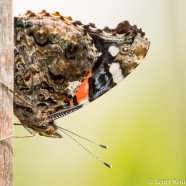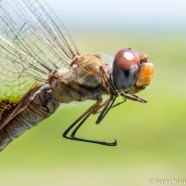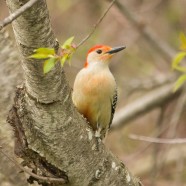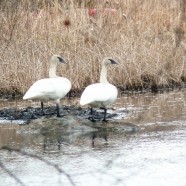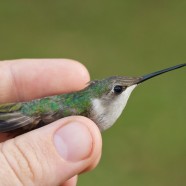Red Admiral
This Red Admiral (Vanessa atalanta) was doing its best job to hide on this fencing, blending in rather well when it was not flashing those bright red orange wing stripes. They have been pouring to the north in the last week, migrating whenever possible in comfortable and calm June conditions. I do not often get to see this side of the species, and I was glad to have a chance to actually see one pausing with all of them floating by. I hope it is having a good trip and things are now looking up. Scott Kruitbosch Conservation & Outreach Coordinator
Read MoreSpot-winged Glider
Today was the best day that I have experienced so far this year for migratory insects! Red Admiral and Monarch butterflies were on the wing, and dozens of dozens of dragonflies were zipping by including Common Green Darners, Black Saddlebags, Carolina Saddlebags, Swamp Darners, Wandering Gliders and Spot-winged Gliders (Pantala hymenaea) like this one. You can see the spots of this very difficult to catch species here. Keep an eye out for Sean’s Meet Your Neighbour photo of it sometime soon. So much more life is emerging every day now that we have entered the summer, and it is so...
Read MoreRed-bellied Woodpecker
In our continuing discussion of why the birds are named the way they are, here we see the reason for the name behind the Red-bellied Woodpecker (Melanerpes carolinus). Yes, they have a red head, but not as red as some woodpeckers that go by that name. These birds have pushed north over the last several decades, inhabiting new breeding grounds and in many cases year-round territories. In the last couple of weeks I have noted an influx of Red-bellied Woodpeckers, especially in migratory hot spots, showing how some definitely do move north. We can see that red belly thanks to these views...
Read MoreTrumpeter Swans (Cygnus buccinator)
Here in Chautauqua County we are accustomed to seeing Tundra Swans (Cygnus columbianus) throughout the migratory and wintering seasons. If you are very lucky you may someday be able to pick out a Trumpeter Swan (Cygnus buccinator) in similar habitats. The Trumpeter Swan, the largest of North America’s waterfowl, was nearly extinct in the early 20th century. Thankfully hunting for feathers for the quill pen market, among others, has ended and their numbers have rebounded. This is also due to hard work by the conservation community in North America. It can be very difficult to separate a...
Read MoreRuby-throated Hummingbird recaptures
Yesterday we recaptured two Ruby-throated Hummingbirds (Archilochus colubris) from previous years here in Costa Rica for the first time. Both of these females were banded last year and returned to the exact same location. They traveled most likely over 4,000 miles round-trip since the last time we saw them. Weighing less than a penny it is incredible what these small tenacious birds can do. Sean Graesser RTPI Affiliate
Read More



